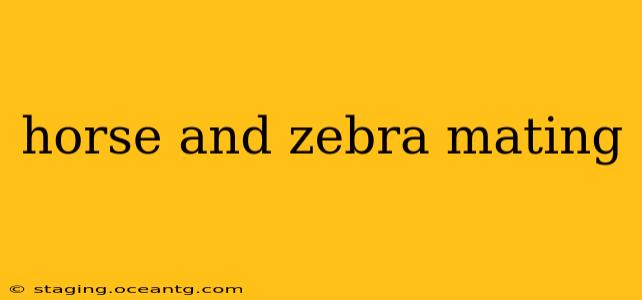The question of whether horses and zebras can mate, and the viability of any offspring, has intrigued both scientists and the public for years. While they are both equids and share a common ancestor, the differences in their genetic makeup lead to some fascinating—and often challenging—outcomes. This article will delve into the topic, exploring the possibilities, the resulting hybrids, and the ethical considerations involved.
Can Horses and Zebras Mate?
Yes, horses and zebras can mate. They are closely related species, and despite their distinct appearances, they are capable of producing offspring. This is known as interspecies breeding or hybridization. However, successful mating isn't guaranteed, and several factors influence the outcome. Compatibility issues, physical differences in size and mating behavior, and the inherent genetic differences can all present obstacles.
What are the Offspring Called?
The offspring of a horse and a zebra are called zebroids. The specific name can vary depending on the parent species of the zebra involved (Plains zebra, Grevy's zebra, Mountain zebra) and sometimes the sex of the parents. For example, a cross between a horse and a plains zebra is often called a zorse. A cross between a donkey and a zebra is a zonkey. The resulting offspring are typically sterile, meaning they cannot reproduce.
Are Zebroids Fertile?
Generally, zebroids are infertile. While rare cases of fertility have been reported, they are exceptional and not the norm. The significant genetic differences between horses and zebras cause issues with chromosome pairing during meiosis, the process that creates reproductive cells. This prevents the formation of viable gametes (sperm and eggs), rendering them unable to reproduce.
What are the Characteristics of Zebroids?
Zebroids inherit a blend of characteristics from both parents. The appearance can vary widely depending on the specific parent animals and the dominance of certain genes. Common traits include a horse-like body shape with zebra-like stripes, which are often less distinct than those found on purebred zebras. Their size, temperament, and overall physical characteristics are variable and unpredictable.
Why Do People Breed Horses and Zebras?
While primarily a scientific curiosity, the breeding of horses and zebras has sometimes been explored for practical purposes. Some have attempted to create hybrids that combine the hardiness and disease resistance of zebras with the docility and strength of horses. However, the infertility of the offspring makes this a less practical approach than other breeding methods for improving livestock. The inconsistent results and the ethical questions surrounding interspecies breeding often outweigh any potential advantages.
Is Breeding Horses and Zebras Ethical?
The ethics of breeding horses and zebras are complex and debated. Concerns surround the welfare of both the parent animals and the often sterile offspring. The process can be stressful for the animals involved, and the resulting zebroids may face health issues due to the genetic incompatibility. Furthermore, the limited success rate and unpredictable outcomes raise ethical questions about the responsible use of animal breeding practices.
What is the Future of Zebroid Breeding?
With the focus increasingly on ethical animal breeding and conservation efforts, the future of zebroid breeding may see a decline. Scientific research focusing on equid genetics might shift from hybrid creation towards understanding the intricacies of interspecies breeding to further conservation goals. There is more focus on preserving the genetic diversity within existing zebra and horse populations rather than creating hybrids.
In conclusion, while the mating of horses and zebras is possible, resulting in fascinating hybrids, the process is not without ethical considerations and practical limitations. The inherent infertility of zebroids and potential animal welfare concerns are important factors to consider when discussing this unique crossbreeding.
